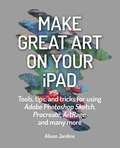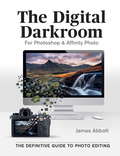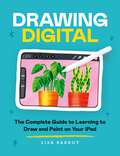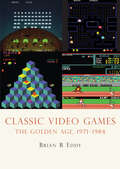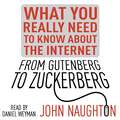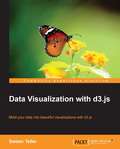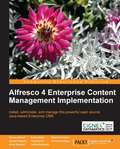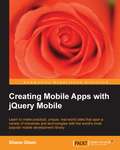- Table View
- List View
Imagine. Shoot. Create.: Creative Photography
by Annegien SchillingAnnegien Schilling started her @fetching_tigerss Instagram account when she was 13 years old. Six years later, she has almost 1 million followers worldwide. Her distinctive, surreal images inspire curiosity about the creative process, and in this book, Annegien shares her signature editing style in great detail. She guides her readers through simple step-by-steps to beautiful, surreal imagery and teaches her successful method of conceiving an idea (Imagine), capturing it correctly (Shoot), and editing them efficiently (Create), all without expensive camera gear or complicated software. This book will inspire you to explore your imagination and create photos you never thought possible!
Imagine. Shoot. Create.: Creative Photography
by Annegien SchillingAnnegien Schilling's imaginative self-portraits inspire just under 1 million followers under the account @fetching_tigerss. In this, her first book, she guides her readers through simple step-by-steps to beautiful, surreal imagery and teaches her successful method of conceiving an idea (Imagine), capturing it correctly (Shoot), and editing them efficiently (Create), all without expensive camera gear or complicated software. This book will inspire you to explore your imagination and create photos you never thought possible!
The Photographers Eye: Instantly Understand Composition & Design for Better Photography (The Photographer's Eye #5)
by Michael FreemanTaking a new look at composition, the theme of his bestselling classic The Photographer's Eye, Michael Freeman now explores the visual mechanics of photography in its own native terms. Lushly illustrated with straight-to-the-point diagrams and graphic deconstructions, this new, digitally remastered edition speaks in that intuitive, visual, and instantaneous language in which photographers think and work.Each section is organized into discrete units that articulate a working method for communicating particular ideas and capturing certain subjects. Dive into beautiful images and explore how each compositional element is placed and arranged in relationship to each other. Examine the outtakes from each shoot to understand why one particular image succeeded, compared to those shot before and after. Track the viewer's eye as it moves throughout the photo to see the optical dynamics held within each frame. And most of all, internalize this graphic language so you can instantly recognise amazing and powerful shots as they appear in your own viewfinder.
In Camera: Perfect Pictures Straight Out Of The Camera
by Gordon LaingWith amazing low-light capabilities, incredible definition, intelligent autofocus and a host of other features, digital cameras have now become so powerful that they have left their users behind. Most photographers can take competent shots in a range of conditions, or fix imperfect exposures in Photoshop or Lightroom, but very few have the skill to push their cameras to the limit and capture the perfect shot, under all conditions, with no post-processing required.In Camera is the perfect way to take your photography to that level; to master your camera, understand light, exposure and composition, and make amazing photographs, whatever your camera, without cheating after the event. One hundred of Gordon's beautiful photos are given with his own expert commentary; full settings and camera details are included, and a host of tips and tricks let photographers of any level learn something from every example. The shots are taken with a wide range of cameras, and the emphasis is on getting results by improving your own skills, not wasting money on expensive equipment.
In Camera: How to Get Perfect Pictures Straight Out of the Camera
by Gordon LaingWith amazing low-light capabilities, incredible definition, intelligent autofocus and a host of other features, digital cameras have now become so powerful that they have left their users behind. Most photographers can take competent shots in a range of conditions, or fix imperfect exposures in Photoshop or Lightroom, but very few have the skill to push their cameras to the limit and capture the perfect shot, under all conditions, with no post-processing required.In Camera is the perfect way to take your photography to that level; to master your camera, understand light, exposure and composition, and make amazing photographs, whatever your camera, without cheating after the event. One hundred of Gordon's beautiful photos are given with his own expert commentary; full settings and camera details are included, and a host of tips and tricks let photographers of any level learn something from every example. The shots are taken with a wide range of cameras, and the emphasis is on getting results by improving your own skills, not wasting money on expensive equipment.
Make Great Art on Your iPad: Draw, Paint & Share
by Alison JardineFully revised to reflect the latest updates in the most popular creativity apps, this is the original, best-selling guide to using creative apps on your Apple device to produce your very own masterpieces. Artists like David Hockney have taken to creating art on the iPad, but you don't have to be an artist to achieve great results on your device. This refreshingly accessible book is perfect for skilled artists and creative wannabes alike. Alongside the step-by-step projects that teach the fundamentals of digital painting, there are also some easy and fun artistic tricks that anyone can try. You'll master the most popular art apps, and you will learn new painting and drawing skills along the way.Includes advice on using Procreate, ArtRage, Art Studio for iPad, Adobe Photoshop Sketch, Pen & Ink, Brushes and Tayasui Sketches Pro.
Make Great Art on Your iPad: Draw, Paint & Share
by Alison JardineFully revised to reflect the latest updates in the most popular creativity apps, this is the original, best-selling guide to using creative apps on your Apple device to produce your very own masterpieces. Artists like David Hockney have taken to creating art on the iPad, but you don't have to be an artist to achieve great results on your device. This refreshingly accessible book is perfect for skilled artists and creative wannabes alike. Alongside the step-by-step projects that teach the fundamentals of digital painting, there are also some easy and fun artistic tricks that anyone can try. You'll master the most popular art apps, and you will learn new painting and drawing skills along the way.Includes advice on using Procreate, ArtRage, Art Studio for iPad, Adobe Photoshop Sketch, Pen & Ink, Brushes and Tayasui Sketches Pro.
How to Photograph Food
by Beata LubasFood photography is a rapidly-growing genre, and whether you're a food blogger looking to take your presentation to the next level, or a professional photographer keen to expand into this lucrative market, this book has everything you need to make it all a piece of cake.Using the techniques she has developed through years of professional success, Beata Lubas will teach you how to anticipate your clients' needs, articulate your own style, and skillfully manufacture sumptuous shots that leap from the page. Learn how to tell food stories using light, colour and shape to evoke atmosphere. Discover methods for shaping natural light to produce magical images in any environment. Combine styling tricks and camera skills to create sensational compositions.With clear, concise and comprehensive instruction to suite every skill level, this book takes you through all the stages involved in creating incredible food photography. So much more than just a guide to photographing food, this is a must-read manual for every photographer working with natural light.
Light & How to Photograph It: The Professional Approach To Capturing Every Type Of Light
by Michael FreemanFor professional photographers, chasing the light, waiting for it, sometimes helping it, and finally capturing it is a constant preoccupation and for some, an obsession. Drawing on four decades of working with light, Michael Freeman takes a simple but practical approach to interpreting, reacting to, and capturing photography's most valuable commodity.Practical advice is organised into three straightforward sections: Waiting, Chasing, and Helping. Begin by mastering the art of patience, and recognise the immense value of anticipating and planning for gorgeous light that's just over the horizon. Then learn the techniques to meet otherwise transient and fleeting lighting conditions halfway, with quick thinking and fast reactions. Finally, make the most of the tools at your disposal to enhance and manipulate light as you find it, covering everything from in-the-field shooting choices to technical transformations in post-production. This is the method of a working professional - to interpret, approach, and master whatever lighting situation is thrown at you and always get the shot, no matter what.
Light & How to Photograph It: The Professional Approach To Capturing Every Type Of Light
by Michael FreemanFor professional photographers, chasing the light, waiting for it, sometimes helping it, and finally capturing it is a constant preoccupation and for some, an obsession. Drawing on four decades of working with light, Michael Freeman takes a simple but practical approach to interpreting, reacting to, and capturing photography's most valuable commodity.Practical advice is organised into three straightforward sections: Waiting, Chasing, and Helping. Begin by mastering the art of patience, and recognise the immense value of anticipating and planning for gorgeous light that's just over the horizon. Then learn the techniques to meet otherwise transient and fleeting lighting conditions halfway, with quick thinking and fast reactions. Finally, make the most of the tools at your disposal to enhance and manipulate light as you find it, covering everything from in-the-field shooting choices to technical transformations in post-production. This is the method of a working professional - to interpret, approach, and master whatever lighting situation is thrown at you and always get the shot, no matter what.
The Digital Darkroom: The Definitive Guide to Photo Editing
by James AbbottPost-production can make the difference between a good image and a great image, not to mention it's an essential process if you shoot in RAW to enjoy the most flexibility and control possible. This book will outline everything you need to know to gain a better understanding of how to apply darkroom style effects to your images using Adobe Photoshop and Affinity Photo.Through detailed background knowledge designed to make you familiar with the software and to build your confidence, you'll learn a wide range of skills and techniques through step-by-step case studies that will make learning an active experience. Not only will this be a valuable reference resource, it will also be your very own personal tutor giving you everything you need to edit your images like a pro. - Learn the essentials with a complete guide to every tool, filter and effect for both Adobe Photoshop and Affinity Photo- Get the most out of your RAW files with detailed instructions on processing your digital image- Master basic, intermediate, and advanced editing techniques with easy to follow step-by-step tutorials- Get the best quality images for display with a complete guide to home printing
The Digital Darkroom: The Definitive Guide to Photo Editing
by James AbbottPost-production can make the difference between a good image and a great image, not to mention it's an essential process if you shoot in RAW to enjoy the most flexibility and control possible. This book will outline everything you need to know to gain a better understanding of how to apply darkroom style effects to your images using Adobe Photoshop and Affinity Photo.Through detailed background knowledge designed to make you familiar with the software and to build your confidence, you'll learn a wide range of skills and techniques through step-by-step case studies that will make learning an active experience. Not only will this be a valuable reference resource, it will also be your very own personal tutor giving you everything you need to edit your images like a pro. - Learn the essentials with a complete guide to every tool, filter and effect for both Adobe Photoshop and Affinity Photo- Get the most out of your RAW files with detailed instructions on processing your digital image- Master basic, intermediate, and advanced editing techniques with easy to follow step-by-step tutorials- Get the best quality images for display with a complete guide to home printing
Complete Photography: Understand cameras to take, edit and share better photos
by Chris GatcumWhether you're a complete beginner, a casual snapper or a seasoned photographer, there is a lot to be learned from this extensive photography guide. Take the guesswork out of your photography and understand not just what to do with your camera, but how and why this affects the photos you take. You'll learn how to compose a shot for visual impact, focus it to attract the viewer's eye, expose it so every detail is captured and so much more. Photography never stands still so it doesn't matter what camera you have, whether you own an SLR, film camera or a compact digital camera, Gatcum will teach you how to take the best photos possible. As well as Gatcum's own expertise on the subject, Complete Photography is packed with tips and masterclasses from other inspirational professionals.
Complete Photography: Understand cameras to take, edit and share better photos
by Chris GatcumWhether you're a complete beginner, a casual snapper or a seasoned photographer, there is a lot to be learned from this extensive photography guide. Take the guesswork out of your photography and understand not just what to do with your camera, but how and why this affects the photos you take. You'll learn how to compose a shot for visual impact, focus it to attract the viewer's eye, expose it so every detail is captured and so much more. Photography never stands still so it doesn't matter what camera you have, whether you own an SLR, film camera or a compact digital camera, Gatcum will teach you how to take the best photos possible. As well as Gatcum's own expertise on the subject, Complete Photography is packed with tips and masterclasses from other inspirational professionals.
How Do I Photograph A Sunset?: More than 150 essential photography questions answered
by Chris GatcumHow do we learn? We learn by asking questions. But what if we don't know what questions we should be asking? Thanks to the digital revolution, photography has never been so popular, and whether you shoot on a phone or a top-spec DSLR or CSC camera, the urge to improve is relentless. In this book, author Chris Gatcum asks the questions that every photographer will have in mind at some point in their image-making journey, and then answers them in a clear, concise, straightforward and inspirational manner. Laid out in intuitive sections, this book tackles the questions that are on every photographer's mind, as well as those that they haven't thought of yet. And with a clear progression through each chapter, from the simple to more complex, the book asks - and answers - questions to satisfy the complete novice as well as the advanced practitioner.
How Do I Photograph A Sunset?: More than 150 essential photography questions answered
by Chris GatcumHow do we learn? We learn by asking questions. But what if we don't know what questions we should be asking? Thanks to the digital revolution, photography has never been so popular, and whether you shoot on a phone or a top-spec DSLR or CSC camera, the urge to improve is relentless. In this book, author Chris Gatcum asks the questions that every photographer will have in mind at some point in their image-making journey, and then answers them in a clear, concise, straightforward and inspirational manner. Laid out in intuitive sections, this book tackles the questions that are on every photographer's mind, as well as those that they haven't thought of yet. And with a clear progression through each chapter, from the simple to more complex, the book asks - and answers - questions to satisfy the complete novice as well as the advanced practitioner.
Drawing Digital: The Complete Guide to Learning to Draw and Paint on Your iPad
by Lisa BardotAcclaimed artist and educator Lisa Bardot gives you all the tools you need to approach creating art and illustration on your iPad, using Procreate and other popular drawing apps.- Explore the core technical aspects of your chosen app, including layers, masks, alpha lock, and brushes.- Learn how to draw plants, flowers, and animals, then move on to drawing people and more complicated scenes.- Step-by-step exercises lead you through each new topic, with plenty of tips, tricks and techniques.- An ideal starting point for newcomers to digital art, but with plenty of original inspiration and advice for more advanced artists.
The Ultimate Photography Ideas Book: 60 Creative Projects Covering Every Major Genre of Photography
by Digital Camera Magazine Niall HamptonFIND NEW WAYS TO SHOOT AND LEARN KEY SKILLS WITH OVER 60 PHOTOGRAPHY PROJECTS FROM EVERY GENRE.Elevate your craft and unleash your creativity with the Ultimate Photography Ideas Book. Requiring simple and minimal kit, this no-nonsense guide is packed with over 60 captivating challenges across every major genre of photography:LANDSCAPES: Try out new techniques for stunning images of the great outdoors.PORTRAITS: Get creative with different ways of shooting people and animals.WILDLIFE & MACRO: Embrace nature both close-up and from a distance.STILL LIFE & CREATIVE: Have fun with inspiring table-top projects.ACTION: Master all the technical skills for capturing subjects on the go.DOCUMENTARY & STREET: Find new ways of looking at your environment.BASIC KIT: Shoot every project on standard kit, or learn how to make what you need!EASY ADVICE: Step-by-step guides and difficulty ratings for every project inside.In partnership with the UK's best-selling photography magazine, this book offers limitless ideas and concise guidance for you to transform ordinary moments into extraordinary works of art.Turn your passion for photography into professional looking images with The Ultimate Photography Ideas Book.
How to Profit from Auctions
by Fiona ShoopTV Programs like Bargain Hunt and Cash in the Attic have increased the publics interest in attending auctions. This invaluable guide shows all the tricks of the trade from looking for costly scratches hidden under labels when buying to negotiating for a better rate when selling, as well as how to arrange free collection and getting the best from your local auction house. Whether you want to learn how to bid so youre seen by the auctioneer or want to ensure your commission bid stands a better chance, antiques expert, Fiona Shoops advice could make you thousands. Contains a glossary to decipher common auction terms, as well as a detailed county by county auction directory with over 600 auctions listed.
Hacker, Hoaxer, Whistleblower, Spy: The Many Faces of Anonymous
by Gabriella ColemanHere is the ultimate book on the worldwide movement of hackers, pranksters, and activists that operates under the non-name Anonymous, by the writer the Huffington Post says "knows all of Anonymous' deepest, darkest secrets."Half a dozen years ago, anthropologist Gabriella Coleman set out to study the rise of this global phenomenon just as some of its members were turning to political protest and dangerous disruption (before Anonymous shot to fame as a key player in the battles over WikiLeaks, the Arab Spring, and Occupy Wall Street). She ended up becoming so closely connected to Anonymous that the tricky story of her inside-outside status as Anon confidante, interpreter, and erstwhile mouthpiece forms one of the themes of this witty and entirely engrossing book.The narrative brims with details unearthed from within a notoriously mysterious subculture, whose semi-legendary tricksters--such as Topiary, tflow, Anachaos, and Sabu--emerge as complex, diverse, politically and culturally sophisticated people. Propelled by years of chats and encounters with a multitude of hackers, including imprisoned activist Jeremy Hammond and the double agent who helped put him away, Hector Monsegur, Hacker, Hoaxer, Whistleblower, Spy is filled with insights into the meaning of digital activism and little understood facets of culture in the Internet age, including the history of "trolling," the ethics and metaphysics of hacking, and the origins and manifold meanings of "the lulz."
Classic Video Games
by Brian EddyIn the early 1970s, video arcade games sprung to life with the advent of Pong and other coin-operated games. Within just a few short years, if you had a quarter, you could go to the video arcade and play Space Invaders, Asteroids, or Pac-Man. If you were lucky enough to have an Atari system hooked up to your television, you could play Frogger or Galaga at home. By the early 1980s, arcade and video games were entrenched as a pop culture phenomenon, with players spending hours in arcades racking up as many points as possible. Arcade games were everywhere: restaurants, bowling alleys, department stores, grocery stores--anywhere that could accommodate a three-foot by five-foot machine. But, just as soon as the phenomenon began, it morphed into something else with the advent of hand-held games and more sophisticated home-gaming systems. Brian Eddy, former executive director, producer, and programmer for Midway Games, traces the evolution of arcade video games in Classic Video Games, giving readers an inside look at the stratospheric rise--and collapse--of the industry. Readers will reminisce about their favorite games, such as Centipede, Ms. Pac-Man, Tron, and Star Wars as they relive the glory days of the classic video game rage of the 1970s and 1980s.
From Gutenberg to Zuckerberg: What You Really Need to Know About the Internet
by John NaughtonJohn Naughton is the Observer's â??Networker' columnist, a prominent blogger, and Vice-President of Wolfson College, Cambridge. The Times has said that his writings, "[it] draws on more than two decades of study to explain how the internet works and the challenges and opportunities it will offer to future generations," and Cory Doctrow raved that "this is the kind of primer you want to slide under your boss's door." In From Gutenberg to Zuckerberg, Naughton explores the living history of one of the most radically transformational technologies of all time. From Gutenberg to Zuckerberg is a clear-eyed history of one of the most central, and yet most taken-for-granted, features of modern life: the internet. Once a technological novelty and now the very plumbing of the Information Age, the internet is something we have learned to take largely for granted. So, how exactly has our society become so dependent upon a utility it barely understands? And what does it say about us that this is so? While explaining in highly engaging language the way the internet works and how it got to be the way it is, technologist John Naughton has distilled the noisy chatter surrounding the technology's relentless evolution into nine essential areas of understanding. In doing so, he affords readers deeper insight into the information economy and supplies the requisite knowledge to make better use of the technologies and networks around us, highlighting some of their fascinating and far-reaching implications along the way.(P)2013 Quercus Editions Ltd
Data Visualization with d3.js
by Swizec TellerThis book is a mini tutorial with plenty of code examples and strategies to give you many options when building your own visualizations.This book is ideal for anyone interested in data visualization. Some rudimentary knowledge of JavaScript is required.
Alfresco 4 Enterprise Content Management Implementation
by Munwar Shariff Snehal ShahThis book distils the hands-on approach of the training courses into a concise, practical book. The emphasis is on getting up and running fast and discovering the scope and power of Alfresco 4 incrementally through practical examples. Though this book is not a developer guide, various examples in the book will help developers to extend Alfresco functionality and to integrate Alfresco with external systems.This book is designed for experienced users, business owners, or system administrators who want to install and use Alfresco in their teams or businesses. Because Alfresco is free, many teams can install and experiment with its ECM features without any upfront cost, often without management approval. You need to have a degree of technical confidence, but you do not require specialist system admin or developer skills to get a basic system up and running.Though this book is not a developer guide, various examples in the book will help you to extend Alfresco functionality and to integrate Alfresco with external systems.
Creating Mobile Apps with jQuery Mobile
by Shane GliserWith ample coded examples and screenshots, the book consists of 10 different projects that will help you master jQuery Mobile. "Creating Mobile Apps with jQuery Mobile" assumes a base level knowledge of web development. If you've used jQuery Mobile before, you're gold. Otherwise, you can pick it up along the way.



